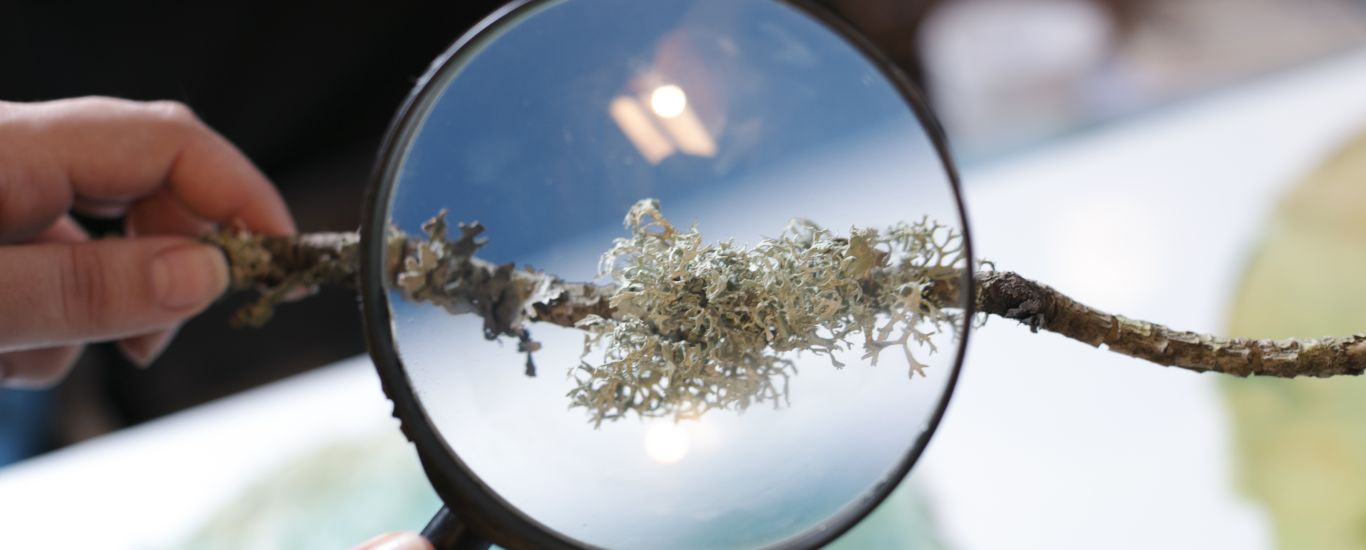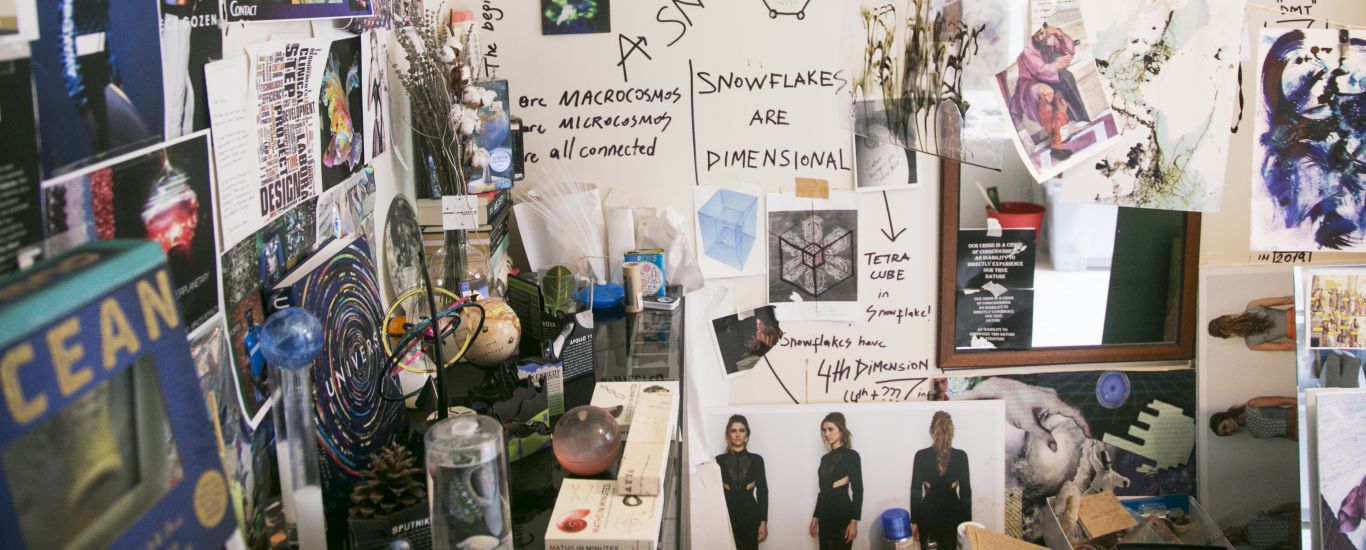Interview and photos by Elif Kahveci
More photos can be accessed here.
Ece Gözen used to be a fashion designer who had proven herself at a young age by winning the MUUSE x VOGUE Talents contest with her university final project Illusional Harmony collection. Following her invitation to London as a reward, she steered towards a different field and found herself involved in various different plans through her research during her postgraduate education at Mimar Sinan Fine Arts University. With Ece, now a material researcher and biodesigner, we spoke of biomaterials and what she has learned in her new path.
.jpg)
Can you tell us about the story of your career beginning from how you were awarded the MUUSE x VOGUE Talents Young Vision Award 2012?
I studied textile and fashion design at Mimar Sinan Fine Arts University and I had published my final project at my personal website. My project somehow spread around online and got featured on some other websites. Vogue Italy editors Sara Maino and Franca Sozzani saw my project and invited me to the contest. I prepared my project presentation in a day and applied for the contest. On December 2012, I got the news that I’ve won.
I left Hakan Yıldırım brand, where I’d worked since I’d started college, and established my own brand, Ece Gözen. Right after that, I got to be one of the designers selected for the Fashion Incube programme. Then I collaborated with the Fabrika brand to create Ece Gözen for Fabrika. In 2016, I was chosen for CFE London’s YOTA programme. Throughout the programme, I had the opportunity to work with people who had previously mentored successful designers such as Mary Katrantzou and Marios Schwab. Upon my arrival to Turkey, I began a brand renovation process and carried my brand to a much larger platform that I named Gozen Institute.
We haven’t been able to see your designs on runways for two years. We’ve heard that you are going on with your work on labs now. What would you like to tell us about your journey from the green rooms to labs?
My mentors at CFE London expressed that they found the philosophical background of my designs admirable and encouraged me to extend it even further. This approach made me question how much I could connect with my own self while manifesting my designer identity. I liked reading about and researching science, I was finding my inspiration in the universe, science and nature. I started to think about my brand again.
While working on a project, my research would take a lot more time than the actual preparation of the collection. Gradually I felt more distant to the idea of deducing all the research I’d done and all the ideas I’d produced during this creative process to a textile product. The idea of Gozen Institute came into its own. After I’ve witnessed the bright and flashy world of fashion, my mindset changed drastically in a jiffy. I’ve realised that the path of my journey was through science, art and design and I was never really at peace with fashion. I was thinking about what I would like to research under Gozen Institute with the motto ‘We are all connected’, since I think everything in the universe is indeed connected. I’ve returned from London with these dreams.
I’ve started to look for a place for the institute I wanted to establish the year I returned [2016]. But due to the state the country was in, everything was uncertain and changing rapidly. Because of that I decided to postpone my search for a location. Now, looking back, I’m glad I didn’t get a place. When I got an offer from Istanbul Moda Academy (IMA) for a teaching position, I realised that I wanted to do something about conveying knowledge. I started my postgraduate studies at Mimar Sinan University. As I started studying sustainable fashion, I’ve gained a deeper knowledge about the damage the fashion industry has on the environment through the research I’ve done. The more I learned the more I drifted away from fashion. Even though that was a time of my life when I held no brief for fashion, I thought that blindly opposing the system was not a productive approach. I always had Buckminster Fuller’s words in mind: “You never change things by fighting against the existing reality. To change something, build a new model that makes the existing model obsolete.” So I started working on biomaterials as a solution.
.jpg)
What’s the significance of biomaterials for sustainable fashion? What sort of a study do you perform in this field?
My research is not intended exclusively for fashion, it aims to make sustainable production models and nature friendly biomaterials available for use in every field. My primary aim is to extend these materials’ area of utilization and raise awareness about the topic.
I work on bio-leather and bioplastic. Bio-leather is a material produced without killing any animals; it’s not processed in a way that would harm the environment and it’s 100% biodegradable.
If we’re talking about the textile industry, even for the organic cotton production, the chemicals and the amount of water being used causes great damage to the environment. The production process of biomaterials causes no harm to the environment and they decompose in nature very quickly. The process is much faster and cleaner compared to animal leather and the amount of water needed is much less, beyond comparison. I think a designer has a responsibility towards the environment and people. As the chosen chief of Nakota, Lakota and Dakota tribes Chief Arvol has said, “Mother Earth is a source of life, not a resource.” If we all represent this belief in our lives and jobs, maybe we can have a chance to give back all the things we took from mother earth so violently thus far.
Can you tell us more about Gozen Institute, and about your current works and future plans?
I imagine Gozen Institute like Raffaello’s The School of Athens. A formation where art, design and science come together with different disciplines such as philosophy, approaching the universe in a holistic manner. I feel very excited to share the information I acquired through research, the connections I made to understand the universe with people through design, art and science.
My husband encouraged me to constitute a room at home as the first location of Gozen Institute. I do my biomaterial tests and research there when I have time left from the lab work. That place is like a notebook that I can record my research in a tangible manner.
My motto is ‘Everything is connected’ and it indeed is. I imagine a place where we can perceive these connections and the language of the universe. In this manner, it is significant for us as members of this world to remember our connection with nature and to strengthen it. For example, when we are introducing materials that we have procured from bacteria, I wish for people to reconsider the distance they put between themselves and these organisms, that they understand that they also are just as perfect as other living things in nature. Even the number of bacteria in our intestines is much larger than the number of stars in a giant galaxy. As human beings, we haven’t come up with any design out of thin air. There is biomimicry and nature in every design we make. I find it important for us to understand this. Before we built our homes, ants were building theirs, perfumes were existent within flowers. I find it necessary for people to leave behind their dominance over nature, and their ego that thinks that they created everything.

Can you tell us a bit about your teaching at IMA? A project you did with your students was presented at Contemporary Istanbul.
We formed a very nice bond with the students at IMA. I’ve seen that they got as excited as I am when I shared Gozen Institute’s main purpose of a holistic educational approach that brings together design, art and science.
Last year when I was doing research on lichen, I reached out to Prof Dr Gülşah Çobanoğlu at Marmara University. She is a biologist who does extended research on lichen. Lichen are a symbiotic organism that bryophytes and fungi form by coming together. With the combined efforts of design and biology students, we produced a work that would honour lichen. Together with my students at IMA, we saw the lichen herbarium at Marmara University. We recreated the forms of lichen we observed under the microscope using the fiber art technique. We presented the small sample taken from lichen and the work side by side. This way, a work that would convey the connection between the micro and the macro cosmos was constituted. During its exhibit at Contemporary Istanbul, it drew the art scene’s attention. We were able to introduce lichen to people and reestablish their value through the language we formed by bringing together science and art.
What are you up to these days?
I’m currently working on a series of educational programmes within Gozen Institute while carrying on with my research and experiments on biomaterials. I want to continue the collaboration I had with the series of seminars I’d previously done with Koç University and other educational institutions. With these programmes that will constitute of seminars and workshops, I want to raise awareness about the environment, biomaterial and organisms and guide people to contemplate about sustainable production. Together, I hope to understand the language of the universe, which is a perfect design.
Can you give us a book, a film and a song that inspires you and that you think contribute to your work?
Book: Holographic Universe - Michael Talbot
Film: (Adapted from Carl Sagan’s book) Contact (Robert Zemeckis, 1997)
Song: “On the Nature of Daylight” - Max Richter










